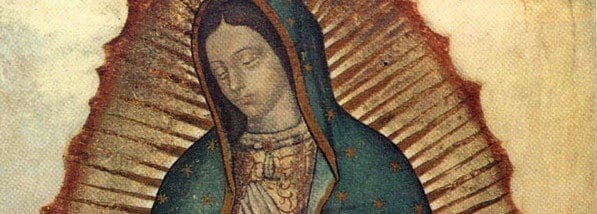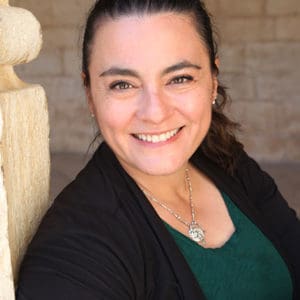This month, in honor of Our Lady of Guadalupe, we’re doing a three-part post on the story of Our Lady of Guadalupe, her miraculous image, and the two shrines dedicated to her in Mexico City and La Crosse, Wisconsin. This story is so rich in detail and fascinating facts, I encourage you to read more about it in Mary of the Americas, A Handbook on Guadalupe, The Story of Our Lady of Guadalupe Empress of the Americas, or Our Lady of Guadalupe and the Conquest of Darkness.
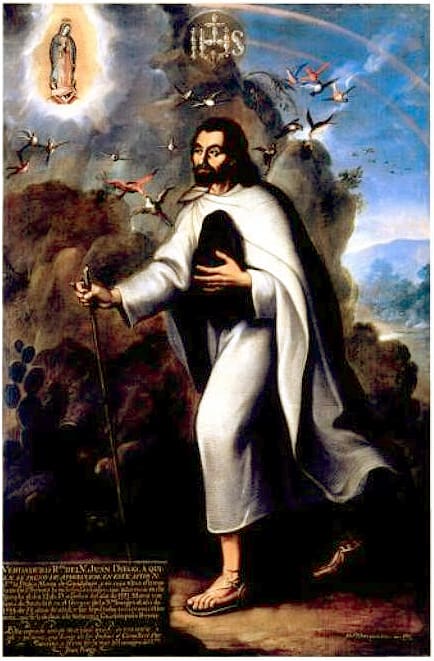 The year was 1531, 39 years after Columbus “discovered” America, ten years after Cortés led the conquest* of the Aztec empire at Tenochtitlan (Mexico City) and seven years after Franciscan missionaries began ministering to the locals, including Juan Diego, who was among the first to be baptized a Catholic. Fifty-seven-year-old Juan was a simple and good man whose wife had recently died, and who was caring for his sick uncle. On December 9th, the Feast of the Immaculate Conception**, Juan was crossing Tepeyac Hill on his way to Mass, when he heard heavenly music and a beautiful voice calling out to him, “Juanito! Juan Diegito!” Juan, unafraid, approached the beautiful lady. When she asked where he was going, he said he was going to Mass. She said,
The year was 1531, 39 years after Columbus “discovered” America, ten years after Cortés led the conquest* of the Aztec empire at Tenochtitlan (Mexico City) and seven years after Franciscan missionaries began ministering to the locals, including Juan Diego, who was among the first to be baptized a Catholic. Fifty-seven-year-old Juan was a simple and good man whose wife had recently died, and who was caring for his sick uncle. On December 9th, the Feast of the Immaculate Conception**, Juan was crossing Tepeyac Hill on his way to Mass, when he heard heavenly music and a beautiful voice calling out to him, “Juanito! Juan Diegito!” Juan, unafraid, approached the beautiful lady. When she asked where he was going, he said he was going to Mass. She said,
“Know for certain, least of my sons, that I am the perfect and perpetual Virgin Mary, Mother of the True God through whom everything lives, the Lord of all things near and far, the Master of heaven and earth. … I desire very much that they build my sacred little house here, in which I will show Him. I will exalt Him in making Him manifest: I will give Him to the people, in my compassionate gaze, in my help, in my salvation, because I am truly your compassionate Mother. I am your merciful mother, the merciful mother of all of you who live united in this land, and of all mankind, of all those who love me, of those who cry to me, of those who seek me, of those who have confidence in me. Here I will hear their weeping, their sorrow, and will remedy and alleviate all their multiple sufferings, necessities and misfortunes.”***
Mary told Juan to go to the palace of the Bishop in Tenochtitlan and tell him what he had seen and heard, and to exhort him to build a temple in her honor. Juan did just that; but, although Fray Juan de Zumarraga had just been praying to the Blessed Mother for help in uniting the people of the land, Juan Diego’s story was… well… hard to believe. He listened to Juan kindly and sent him on his way, withholding judgment but feeling many reservations.
Juan felt like a failure. Back on Tepeyac Hill, he told Mary what had happened. “I beg you, my holy one, my Lady,” he implored, “to choose one of the noblemen who are well known, revered and respected to undertake this so that your words will be believed. It is true, I am only a poor man. I am not worthy of going where you send me. Pardon me, my Lady and my Child, I do not wish to make your noble heart sad. I do not want to displease you.”
The Blessed Mother looked on him with compassion and said,
“Hear me, my son. It is true that I do not lack servants or ambassadors to whom I could entrust my message so that my will could be fulfilled. But it is important that you speak for me in this matter, tired as you are.”
Juan returned to the Bishop the next day, but the Bishop was getting annoyed. All he had was Juan’s word; how could he trust him in such a serious matter? He told Juan to ask the Lady for a sign. Juan left, assuring him that he would get one from the Queen of Heaven.
 Mary promised Juan that she would give him the sign he needed the next day, but when Juan returned home, he found his uncle sick to the point of death. Juan spent the next day caring for his uncle, forgetting his meeting with Mary. The morning of December 12th, as Juan hurried to the city to find a priest to give his uncle the Last Rites, he remembered his missed meeting and felt ashamed. He decided to take another route, hoping to avoid an embarrassing meeting with Mary, but she met him at the bottom of the hill. Juan fell to his knees and begged forgiveness. He wasn’t trying to hurt her feelings or ignore her wishes, but his uncle was so sick, and he had to get a priest!
Mary promised Juan that she would give him the sign he needed the next day, but when Juan returned home, he found his uncle sick to the point of death. Juan spent the next day caring for his uncle, forgetting his meeting with Mary. The morning of December 12th, as Juan hurried to the city to find a priest to give his uncle the Last Rites, he remembered his missed meeting and felt ashamed. He decided to take another route, hoping to avoid an embarrassing meeting with Mary, but she met him at the bottom of the hill. Juan fell to his knees and begged forgiveness. He wasn’t trying to hurt her feelings or ignore her wishes, but his uncle was so sick, and he had to get a priest!
Our Lady looked at Juan with love and said,
“Hear and let it penetrate your heart, my dear little son: let nothing discourage you, nothing depress you. Let nothing alter your heart or your countenance. Also do not fear any illness or trouble, anxiety or pain. Am I not here who am your Mother? Are you not under my shadow and protection? Am I not your fountain of life? Are you not in the fold of my mantle, in the crossing of my arms? Do not be troubled or take thought of your uncle’s illness, for he will not die of this. He is well already. Is there anything else you need?”
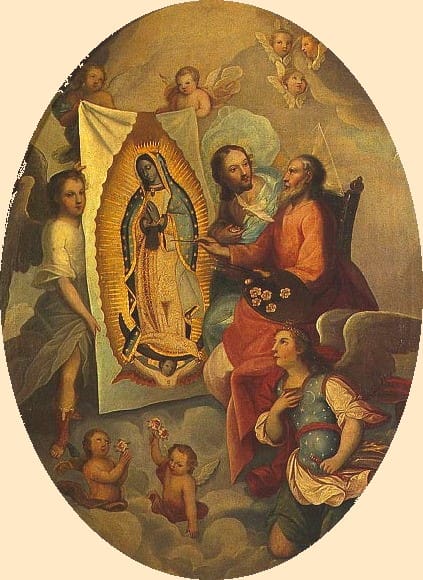 Juan said he would go to the Bishop with whatever sign the Blessed Mother gave him. She told him to go to the top of the hill where he would find many flowers. There, he should cut the roses, gather them in his cactus-fiber cloak, or tilma, and bring them back to her. Juan immediately obeyed, not questioning the fact that it was the middle of December, and that there was absolutely no way he would ever find roses on that barren hill. But Juan found the hill covered in Castilian roses, not native to Mexico. He brought the flowers back, and as Mary rearranged them in his tilma, she said,
Juan said he would go to the Bishop with whatever sign the Blessed Mother gave him. She told him to go to the top of the hill where he would find many flowers. There, he should cut the roses, gather them in his cactus-fiber cloak, or tilma, and bring them back to her. Juan immediately obeyed, not questioning the fact that it was the middle of December, and that there was absolutely no way he would ever find roses on that barren hill. But Juan found the hill covered in Castilian roses, not native to Mexico. He brought the flowers back, and as Mary rearranged them in his tilma, she said,
“My little son, these roses are the sign that you must take to the Bishop. In my name, tell him that with this, he will see and recognize my will, and that he must do what I ask.”
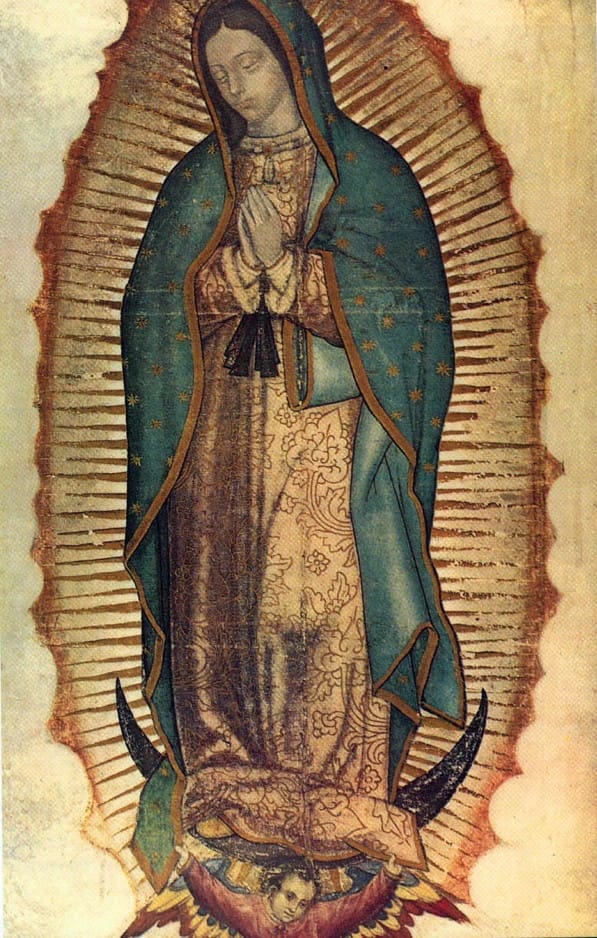 As Juan recounted the tale to the Bishop, he dropped the hem of his tilma, letting the fragrant roses fall to the floor. The Bishop and his retinue dropped to their knees as they saw, imprinted on Juan’s tilma, a full-length image of the Virgin Mary. That image, still intact 482 years later, can still be seen at the Basilica of Our Lady of Guadalupe, near Tepeyac Hill in Mexico City.
As Juan recounted the tale to the Bishop, he dropped the hem of his tilma, letting the fragrant roses fall to the floor. The Bishop and his retinue dropped to their knees as they saw, imprinted on Juan’s tilma, a full-length image of the Virgin Mary. That image, still intact 482 years later, can still be seen at the Basilica of Our Lady of Guadalupe, near Tepeyac Hill in Mexico City.
When Juan returned home, his uncle was healthy and Juan was happy to recount his meeting with a beautiful lady who healed him and told him her name: Guadalupe. Since Our Lady spoke to Juan and his uncle in their native language of Nahuatl, it is believed that she called herself Hehuatzin ni Coatlaxupeuh, which means “I am she who crushed the serpent,” referring to the child-devouring Aztec snake goddess Coalticue, whose temple used to be atop Tepeyac Hill. In the end, the ancient chronicles of the apparition state, “The Virgin did not give the reason why she called her image Guadalupe. So it will not be known until God discloses this mystery.”
Tomorrow, we’ll look more closely at Juan’s tilma and its symbolism and miraculous characteristics.
* While some consider the conquest of the Aztecs to have been the cruel wiping out of an entire civilization, it is important to remember that Cortez’ intention was to eradicate the regular and ruthless human sacrifices that were being carried out every day on top of Aztec pyramids.
** The Immaculate Conception of Mary had been celebrated on December 9th as early as the 5th century. The feast was changed to December 8th in the Roman calendar in the 8th century. This year, we celebrate it again on the 9th because the 8th falls on a Sunday in Advent.
*** The account of these apparitions comes from a translation of the Nican Mopohua, the original account written in Nahuatl by Antonio Valeriano in 1556, which is housed in the Stephen A. Schwarzman Building of the New York Public Library.
Special thanks to Sister M. Ancilla, FSGM, MA, of the Shrine of Our Lady of Guadalupe for her invaluable insight and editorial assistance.
++++++++++++++++++++++++++++++++++++++++++++++++++++++++++++++++++++++++++++++
Art: Fiel retrato do venerável Juan Diego (True picture of Venerable [now Saint] Juan Diego), Miguel Cabrera, 1752, PD-US author’s life plus 100 years or less; Mirror of Old painting of Juan Diego by Miguel Cabrera, uploaded by Bewareofdog, 13 December 2006, PD-US author’s life plus 70 years or less; Painting of God [Eternal Father] painting the Virgin of Guadalupe, anonymous, eighteenth century, photographed by proyectoguadalupe.com, author’s life plus 70 years or less; Virgin of Guadalupe, 16th century (“this version slightly darkened”), PD-US author’s life plus 70 years or less; all Wikimedia Commons.



